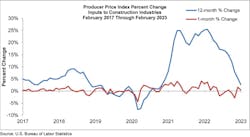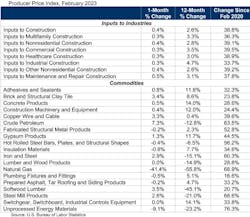BLS: Construction Input Costs Rose 0.4 Percent In February
PRESS RELEASES
Washington, DC, March 15, 2023 -- The price of materials and services used in nonresidential construction increased by 0.4% from January to February, outpacing the 0.1% increase in contractors’ bid prices, according to an analysis by the Associated General Contractors of America (AGC) of new government data. Association officials urged the Biden Administration to rethink planned Buy America limits on the materials firms can use on a broad range of projects that will make many key materials even more expensive.
“Today’s price report shows that construction costs are not necessarily settling back to ‘normal’,” said AGC Chief Economist Ken Simonson. “A resurgence of prices for glass, metals, cement, and paving materials suggests many projects may get more expensive in coming months."
Added Anirban Basu, chief economist for rival Associated Builders and Contractors (ABC), "While the February construction materials price inflation data appear benign, a peek behind the headline numbers indicates that price pressures remain abundant... As an example, the price of brick and structural clay tile expanded 3.4% for the month and is up nearly 9% over the past year. The price of copper wire and cable increased 3.3% on a monthly basis and is up 40% since February 2020. In large measure, sharp declines in energy prices have pushed headline numbers lower in recent months, but there is plentiful evidence of lingering materials price inflation and supply chain challenges in the data."
The producer price index (PPI) for inputs to nonresidential construction—the prices charged by goods producers and service providers such as distributors and transportation firms—climbed 0.4% from January to February. That topped the 0.1% rise in the price index for new nonresidential building construction, a measure of what contractors say they would charge to put up a specific set of buildings.
Moreover, the mild overall reading for input costs masked substantial price increases from January to February for several key building blocks, Simonson noted. The price index for flat glass soared by 4.0 percent, the largest one-month increase in 40 years. The index for steel mill products jumped 2.6%, following eight consecutive monthly declines. The index for copper and brass mill shapes rose for the fourth month in a row, by 2.3%, while the index for aluminum mill shapes posted a 2.9% rise, on top of a 3.3% spike in January. The index for asphalt paving mixtures and blocks climbed 2.2% in February and the index for cement rose for the ninth-straight month, by 1.1%.
This diverse set of price increases outweighed decreases in a few inputs that benefited from a recent drop in oil and natural-gas prices. The price index for diesel fuel fell 3.1%. The index for truck transportation of freight slid 0.8 percent and the index for plastic construction products declined 0.5%.
AGC officials said the Biden administration’s proposed Buy America requirements will severely limit construction firms’ ability to procure key construction materials and contribute to new inflationary pressure on the cost of those items. AGC again urged the White House to rethink its proposed Buy America regulations for recipients of federal construction funds to align with the rules that apply to direct federal projects.
“Limiting the availability of materials used on the billions in federally funded construction projects planned for the coming years will needlessly inflate the cost of construction and contribute to broader inflationary pressure,” said AGC CEO Stephen E. Sandherr. “Instead, they should allow for the same kind of flexibility on federally-funded state and local projects that exists when the federal government procures its own construction projects.”
For his part, Basu also expressed broader concerns.
“With growing pressure on the global banking system and the Federal Reserve still wrestling with excess inflation, risks of recession continue to expand,” he said. “While contractors performing public construction and working on industrial megaprojects stand to fare well during the years ahead, the fortunes of many other contractors are increasingly threatened by elevated costs of capital, tightening financial conditions and the rising cost of delivering construction services. Eventually, these factors could whittle away at backlog, which is currently elevated, creating greater challenges for contractors in 2024 and/or 2025.”
##########

